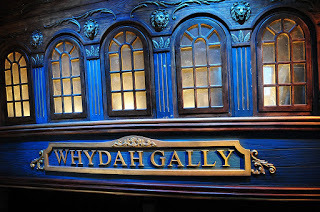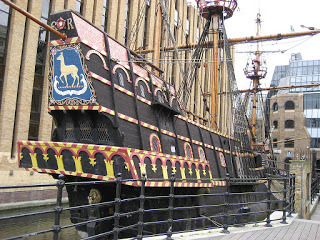Pirates Ships - What’s in a Name?
Pirates were pretty good at brand recognition. No, really. Consider the following. Pirates didn’t attack prey haphazardly. Despite popular belief instilled by books and movies, pirates would rather use scare tactics and nasty reputations than engage in a sea battle. Battles used valuable resources such as ammunition. Crewmen could be hurt or killed. The prize could be damaged or sunk, defeating the purpose of plundering goods, stealing treasure, or seizing the ship for their own. So when they sailed upon a quarry, it was preferred the victim surrender before no quarter was given.
The first indication a pirate ship was closing in would be their colors. The flags pirates hoisted were recognizable, often red or black and depicting skulls, bones, blood, swords, and even an hourglass, a warning to their prey time was running out. When a Jolly Roger snapped in the wind, there was no question the ship claimed no country and that danger was on the horizon.
It would only make sense that pirates would also use branding with the names they chose for their ships.
 Sam Bellamy's flagship
Sam Bellamy's flagship
While some pirates never bothered with renaming the ships they seized, most christened their newly acquired vessels with names that held meaning. Many ships were named according to their profession—adventure, fancy, ranger, fortune. Some monikers were meant to boost fear—revenge, delivery, rover, triumph. Others made political statements. It has been suggested that Edward Teach (1680-1718), famously known as Blackbeard, was a Jacobite sympathizer and had named his flagship Queen Anne’s Revenge in support of England’s deposed Queen Anne.
Here is a list of other notable pirates and the ships they captained.
Jeanne de Clisson (1300-1359) - The Black Fleet, RevengeSir Francis Drake (1540-1596) - Golden HindPeter Easton (1570-1620) - Happy AdventureHenry Morgan (1635-1688) - SatisfactionWilliam Kidd (1645-1701) - Adventure Galley, Adventure PrizeThomas Tew (1649-1695) - AmityLaurens DeGraaf (1653-1704), Anne Dieu-Le-Veut (1661-1710) - Tigre, Francesca, Fortune renamed NeptuneHenry Avery (1659-1699) - FancyCharles Vane (1680-1721) - Lark, RangerBenjamin Hornigold (1680-1719) - RangerRichard Worley (?-1718) - New York’s Revenge
 The Golden Hind (replica) William Moody (?-1719) - Rising SunRobert Sample (?-1719) - Flying KingBartholomew Roberts aka Black Bart (1682-1722) - Royal Rover, Fortune, Good Fortune, Great Ranger, Little RangerEdward England (1685-1721) - Royal James, Fancy, RangerJack Rackham aka Calico Jack (1682-1720), Mary Read(1685-1721), Anne Bonny (1697-possibly 1782) - WilliamStede Bonnet (1688-1718) - Revenge renamed Royal JamesSam Bellamy aka Black Sam (1689-1717) - Whydah GalleyGeorge Lowther (?-1723) - DeliveryChristopher Condent (1690s-1770) - The Flying DragonEdward “Ned” Low (1690-1724) - Rebecca, Fancy, Rose Pink, Merry ChristmasJohn Gow (1695-1725) - FortuneChing Shih (1775-1844) - a whole fleet called the Red Flag FleetJean Lafitte (1780-1823) - Dorada It’s interesting to note how many ships possessed the same or similar names. Is that because of brand recognition? Possibly. No sense in changing what works. Huzzah!
The Golden Hind (replica) William Moody (?-1719) - Rising SunRobert Sample (?-1719) - Flying KingBartholomew Roberts aka Black Bart (1682-1722) - Royal Rover, Fortune, Good Fortune, Great Ranger, Little RangerEdward England (1685-1721) - Royal James, Fancy, RangerJack Rackham aka Calico Jack (1682-1720), Mary Read(1685-1721), Anne Bonny (1697-possibly 1782) - WilliamStede Bonnet (1688-1718) - Revenge renamed Royal JamesSam Bellamy aka Black Sam (1689-1717) - Whydah GalleyGeorge Lowther (?-1723) - DeliveryChristopher Condent (1690s-1770) - The Flying DragonEdward “Ned” Low (1690-1724) - Rebecca, Fancy, Rose Pink, Merry ChristmasJohn Gow (1695-1725) - FortuneChing Shih (1775-1844) - a whole fleet called the Red Flag FleetJean Lafitte (1780-1823) - Dorada It’s interesting to note how many ships possessed the same or similar names. Is that because of brand recognition? Possibly. No sense in changing what works. Huzzah!
About the Author
Jennifer is the award-winning author of the Romancing the Pirate series. Visit her at www.jbrayweber.com or join her mailing list for sneak peeks, excerpts, and giveaways.
The first indication a pirate ship was closing in would be their colors. The flags pirates hoisted were recognizable, often red or black and depicting skulls, bones, blood, swords, and even an hourglass, a warning to their prey time was running out. When a Jolly Roger snapped in the wind, there was no question the ship claimed no country and that danger was on the horizon.
It would only make sense that pirates would also use branding with the names they chose for their ships.
 Sam Bellamy's flagship
Sam Bellamy's flagshipWhile some pirates never bothered with renaming the ships they seized, most christened their newly acquired vessels with names that held meaning. Many ships were named according to their profession—adventure, fancy, ranger, fortune. Some monikers were meant to boost fear—revenge, delivery, rover, triumph. Others made political statements. It has been suggested that Edward Teach (1680-1718), famously known as Blackbeard, was a Jacobite sympathizer and had named his flagship Queen Anne’s Revenge in support of England’s deposed Queen Anne.
Here is a list of other notable pirates and the ships they captained.
Jeanne de Clisson (1300-1359) - The Black Fleet, RevengeSir Francis Drake (1540-1596) - Golden HindPeter Easton (1570-1620) - Happy AdventureHenry Morgan (1635-1688) - SatisfactionWilliam Kidd (1645-1701) - Adventure Galley, Adventure PrizeThomas Tew (1649-1695) - AmityLaurens DeGraaf (1653-1704), Anne Dieu-Le-Veut (1661-1710) - Tigre, Francesca, Fortune renamed NeptuneHenry Avery (1659-1699) - FancyCharles Vane (1680-1721) - Lark, RangerBenjamin Hornigold (1680-1719) - RangerRichard Worley (?-1718) - New York’s Revenge
 The Golden Hind (replica) William Moody (?-1719) - Rising SunRobert Sample (?-1719) - Flying KingBartholomew Roberts aka Black Bart (1682-1722) - Royal Rover, Fortune, Good Fortune, Great Ranger, Little RangerEdward England (1685-1721) - Royal James, Fancy, RangerJack Rackham aka Calico Jack (1682-1720), Mary Read(1685-1721), Anne Bonny (1697-possibly 1782) - WilliamStede Bonnet (1688-1718) - Revenge renamed Royal JamesSam Bellamy aka Black Sam (1689-1717) - Whydah GalleyGeorge Lowther (?-1723) - DeliveryChristopher Condent (1690s-1770) - The Flying DragonEdward “Ned” Low (1690-1724) - Rebecca, Fancy, Rose Pink, Merry ChristmasJohn Gow (1695-1725) - FortuneChing Shih (1775-1844) - a whole fleet called the Red Flag FleetJean Lafitte (1780-1823) - Dorada It’s interesting to note how many ships possessed the same or similar names. Is that because of brand recognition? Possibly. No sense in changing what works. Huzzah!
The Golden Hind (replica) William Moody (?-1719) - Rising SunRobert Sample (?-1719) - Flying KingBartholomew Roberts aka Black Bart (1682-1722) - Royal Rover, Fortune, Good Fortune, Great Ranger, Little RangerEdward England (1685-1721) - Royal James, Fancy, RangerJack Rackham aka Calico Jack (1682-1720), Mary Read(1685-1721), Anne Bonny (1697-possibly 1782) - WilliamStede Bonnet (1688-1718) - Revenge renamed Royal JamesSam Bellamy aka Black Sam (1689-1717) - Whydah GalleyGeorge Lowther (?-1723) - DeliveryChristopher Condent (1690s-1770) - The Flying DragonEdward “Ned” Low (1690-1724) - Rebecca, Fancy, Rose Pink, Merry ChristmasJohn Gow (1695-1725) - FortuneChing Shih (1775-1844) - a whole fleet called the Red Flag FleetJean Lafitte (1780-1823) - Dorada It’s interesting to note how many ships possessed the same or similar names. Is that because of brand recognition? Possibly. No sense in changing what works. Huzzah! About the Author
Jennifer is the award-winning author of the Romancing the Pirate series. Visit her at www.jbrayweber.com or join her mailing list for sneak peeks, excerpts, and giveaways.
Published on March 13, 2018 01:30
No comments have been added yet.



